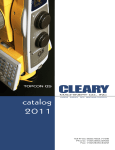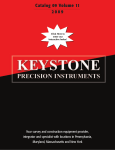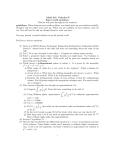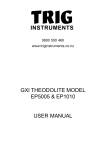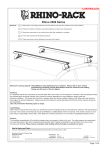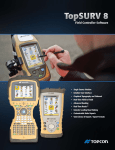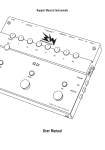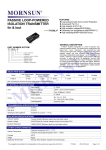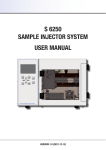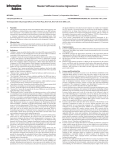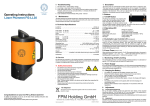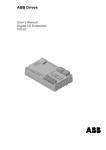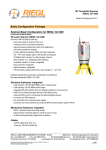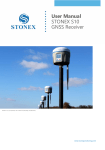Download The Technical Side: Is It The Instrument?
Transcript
TECHNICALITIES The Technical Side: Is It The Instrument? By Chris Cothrun, Service Technician, Ingenuity, Inc. In this installment of The Technical Side we are going to approach instrument errors from the surveyor’s viewpoint. The field crews aren’t out looking for "splits" while turning angles, they are trying to get work done. When they see a problem, they see it in the context of the work they are doing. Perhaps they can’t check back to their backsight to within a couple of hundredths or they try to check in to control and can’t. How many field crews begin the day or an occupation by checking the condition of the instrument and environment? We are going to ana lyze some of these problems and relate them to actual equipment conditions. I ’m going to start with errors that don’t come from the equipment. We occasion ally see bad data or bad calculations blamed on the instrument. Can you check the data you are using? Can you repeat the problem, independent of the data? A much more common problem is user er ror. I can’t tell you how to avoid making mistakes but I can touch on a few ways to detect them. First off, use multiple observations with both faces of the in strument. Turning multiple angles or us ing direct-reverse readings allows you to find the sighting errors. Be aware of and eliminate instrument errors. Second, log all the raw angles and distances. Whether this is in a field book or in a data collector, this raw information allows you to check and recalculate the work you did. Finally, practice proper procedures using common sense. Environmental conditions affect the measurements you make. There are all kinds of electromagnetic interference that will cause problems with electronic instruments. High power hand-held ra dios have a demonstrable effect on the angles and distances measured with a total station. Your cellular phone may also affect your EDM. We have also seen the occasional problem with high voltage power lines and radio or RADAR trans mission towers interfering with instru 26 ments. Something many field crews seem to have little knowledge about is the proper correction for temperature and pressure (PPM). I’ve seen instruments come through the shop with a wide range of settings and heard some strange things from field crews. If you need more infor mation on PPM settings, take a look at the previous articles (reference: Summer 1995 issue of The Ontario Land Surveyor Quarterly) we have done on the subject. Temperature changes and direct sun light will also affect the accuracy of in struments. Noticeable sensitivity to temperature changes can indicate prob lems elsewhere. If you suspect a problem of this nature, have a service technician take a look at the instrument. Take the time to educate yourself and your field crews on these problems. "Your cellular phone may also affect your EDM ." Don’t forget your accessories when you try to track down equipment prob lems. A loose tripod or tribrach is going to give you random errors in your hori zontal angles and your instrument is not going to stay leveled up. You need to make sure your prisms and targets are in good working condition. Prism poles and tribrachs should have the vials and the optical plummet checked to ensure they are not contributing sources of error. We often spend hours chasing nonexistent instrument errors only to find it is the other field equipment that is causing the problem. We will also touch briefly on some of the mechanical problems that you might see in the field. The telescope and stand ards should move smoothly and without excessive noise or play. The tangents, the level screws, and the focus mechanism should also have an even, smooth feel. If any of these are excessively loose or tight the instrument needs service or adjust ment. Mechanical problems in the bear ings or focus assemblies can directly affect instrument accuracy. Tangent problems can affect your ability to posi tion the reticle on the target. Some of these problems are easily corrected while others require more extensive service to prevent major damage to the instrument. Next, level problems. What do the crews have to say when they bring me a level? They can’t close a loop, they can’t check in to benchmarks, or they pegged it and it was out. They might have even adjusted it but are still having problems. First, check the adjustment and condition of the instrument. Has the instrument been dropped or abused? If the level has been adjusted but you are still getting bad results in the field the compensator may need to be checked. If the compensator is not adjusted properly, your level line of sight will change as the level is slightly out of level. Compensator adjustments have to be done by a qualified service technician. What if you suspect bad distances from an EDM? Your first step in the field would be to try to isolate the error to the EDM itself. That would mean eliminat ing the environmental conditions men tioned above. You would also want to eliminate equipment problems such as the optical plummet or the prisms that you are using. If the problem persists, you need to obtain as much information as possible in the field. This would in clude the problem distances, the size of the error, environmental conditions, the prism(s) used and anything else you sus pect is affecting the measurement. This will help the service technician quickly find and correct the problem. How about bad elevations with a total station? First, consider the degree of ac curacy that you should expect for the shot. The total station can display an elevation if it can measure the distance The Ontario Land Surveyor Quarterly, Spring 1996 TECHNICALITIES but you can’t expect the same quality of elevation over thousands of feet. You usually don’t measure that kind of dis tance with a level, do you? You also have to ensure you can clearly resolve the prism. Targets will make the prism easier to sight and will tighten up your "trig elevations." If you feel the instrument might be the source of the problem, check the vertical angles that the instrument is measuring. The direct and reverse face measurements to any target should add up to 360 degrees. If not, most of the total stations allow you to easily correct this in the field. Check your user manual or con sult your local repair shop for detailed instructions. The last area of instrument errors are in horizontal angle measuring and hori zontal positioning. The most common is a "split" in the readings. You see this when you do a direct and reverse meas urement to a target and the horizontal angles are not 180 degrees apart. This may be caused when the instrument reti cle is not centered in the standing axis. You will also see errors in horizontal angles when the telescope axis is not perpendicular to the standing axis or the instrument is not correctly leveled up. The first two are correctable by direct and reverse face measurements, the last is not. These errors increase the farther the telescope is moved above or below 90 degrees. These problems are best cor- "I’ve seen instruments ... with a wide range o f settings and heard some strange things from field crews." rected using optical collimators to adjust the instrument. Adjustment error in the optical plummet will result in horizontal angle reading errors because the instru ment is not accurately positioned over the point. Errors in leveling will also contrib ute to similar horizontal positioning er rors. Consult the various surveying ref erence books for a comprehensive dis cussion of these instrument errors. When you bring me an instrument for service or to correct a problem you aid my job immensely by being able to accu rately describe the problem. I’m going to ask for some of the same information that was discussed in this article. I generally need to duplicate the problem you are seeing before I can correct the problem. I can’t cover every problem you might encounter, but I have given you some guidelines to isolate and identify prob lems. If you need any of the information that was covered in greater detail in pre vious articles, please feel free to a contact us. As always, you can contact us at The Technical Side, 1562 Linda Way, Sparks, NV 89431, fax us at (702)359-6693, or E-mail us at: [email protected]. © 1995 Ingenuity Inc.


